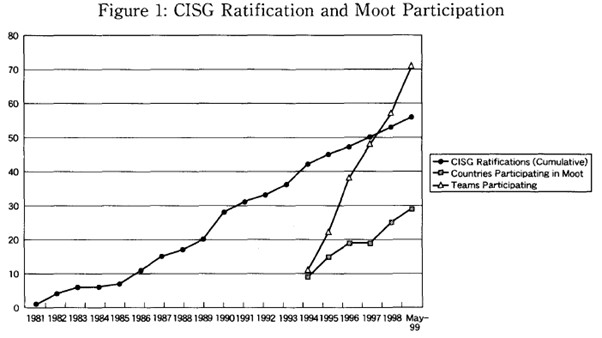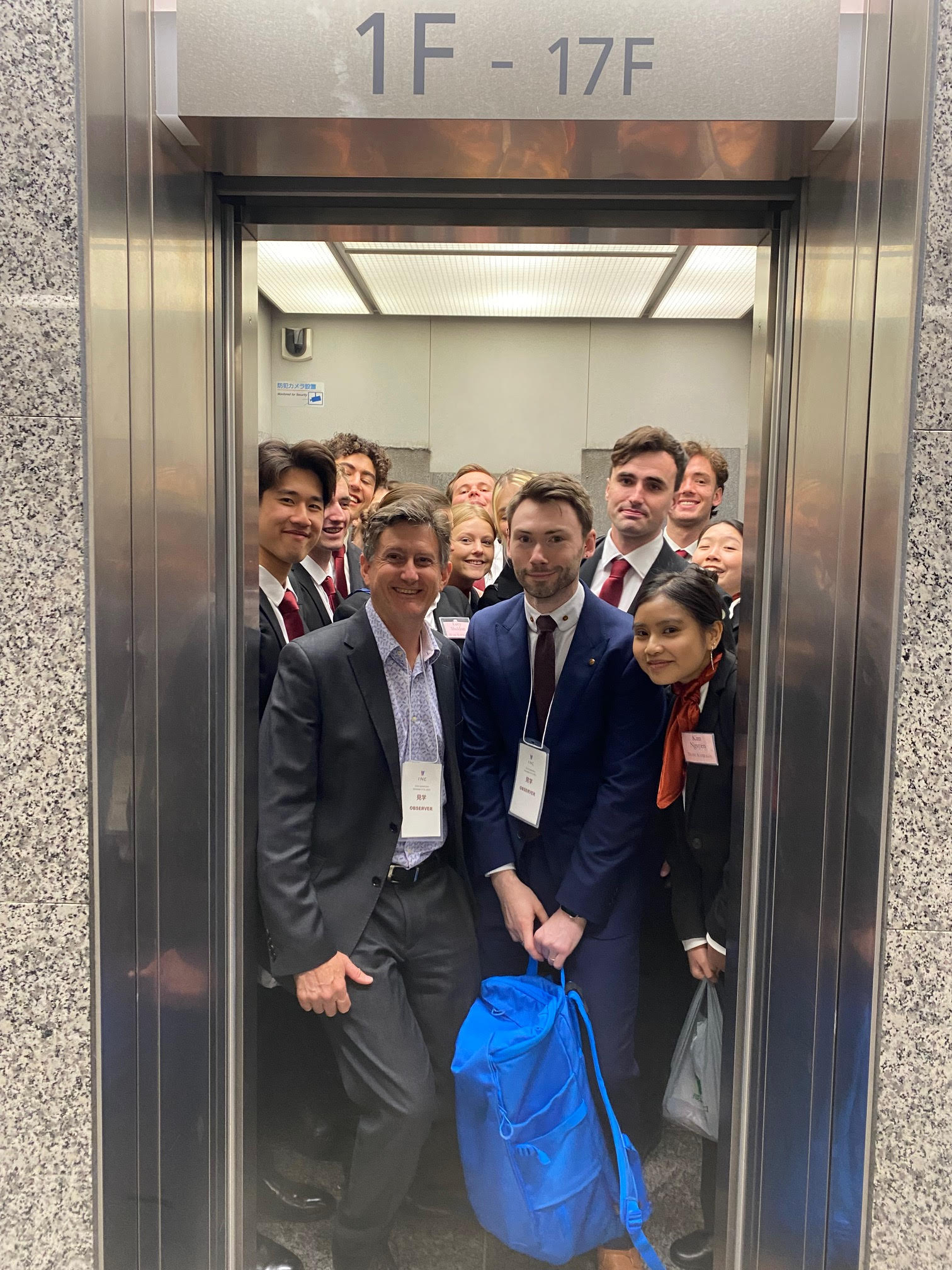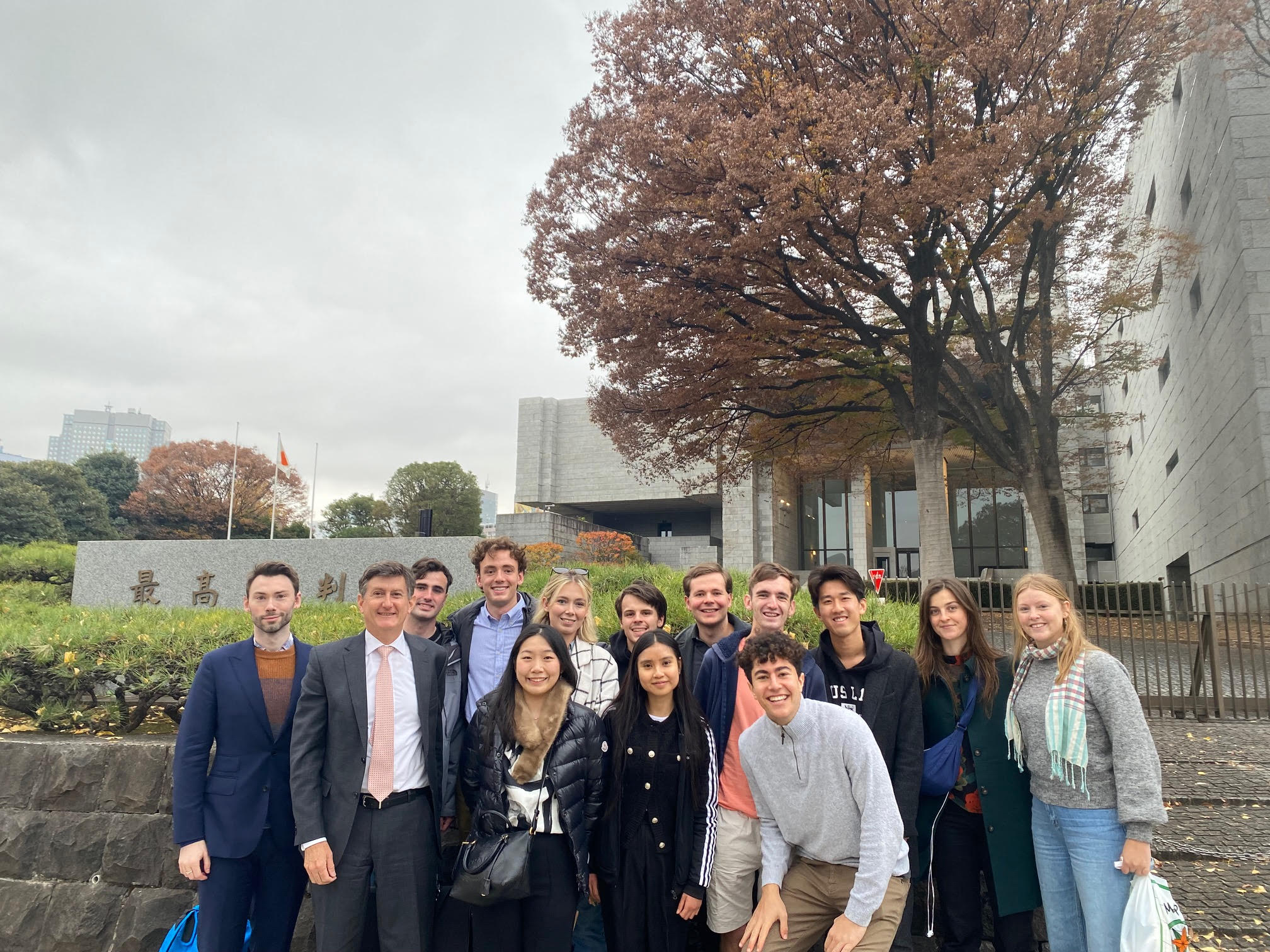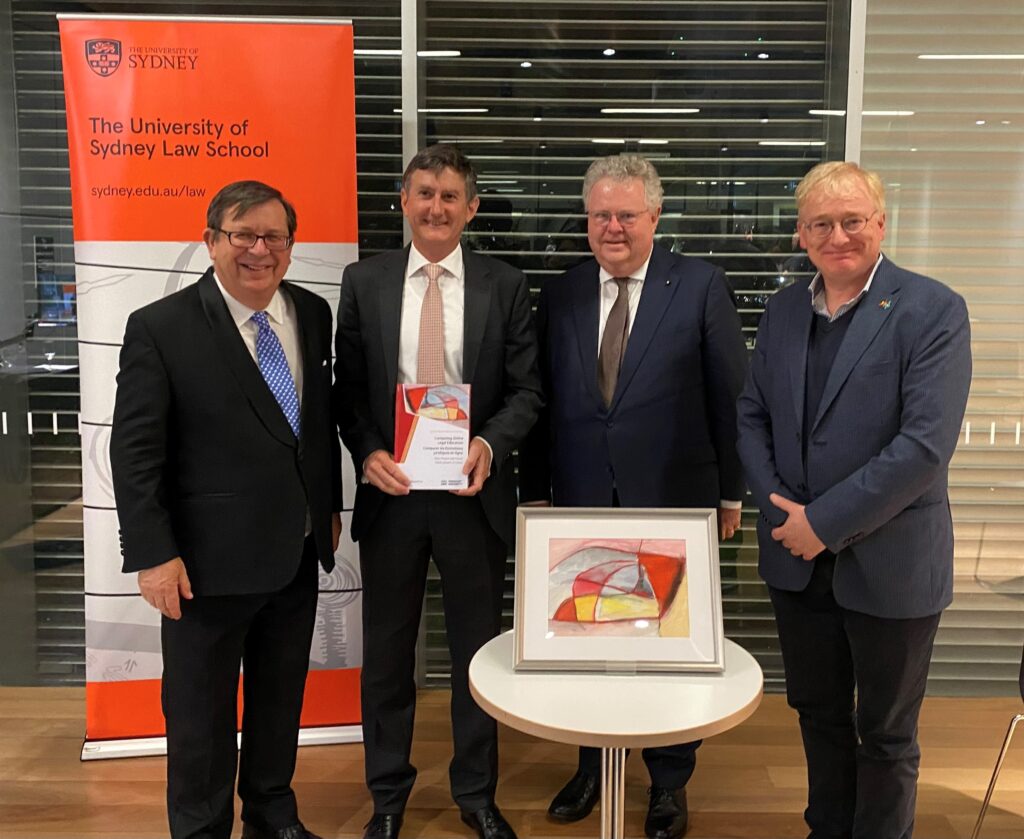[Editor’s updated note: My father Richard Nottage, former Secretary of Foreign Affairs and Trade of New Zealand (1991-9) as well as ambassador to Japan, Indonesia and Geneva (UN and WTO), died peacefully in Wellington on 11 October 2025, aged 85. After retirement in 2000 he was Deputy Chair of the Asia New Zealand Foundation and Inaugural Chair of the National Archives Council, as he was keenly interested in history especially in Asia. A full obituary is here and a video of Richard discussing the creation of the WTO is here. I am updating slightly a blog posting below from 2011 in his memory, reproducing from here a book review we co-authored around then.]
[Original editor’s note: Below is an overview of an intriguing book with this self-explanatory title, reviewed by my colleague specialising in public international law, A/Prof Ben Saul; and a former Research Assistant at our Sydney Centre for International Law, Naomi Hart. Their Review was published in [2010] Australian International Law Journal 295-9. The full PDF version, including footnote references, is downloadable here.
My own Review of this book co-authored by Professor Neil Boister (University of Canterbury) and Robert Cryer (University of Birmingham), appeared in [2010] 8 New Zealand Yearbook of International Law 343-50. That Review [also reproduced immediately below] is written with my father, Richard Nottage, who in the 1960s undertook post-graduate research into pre-WW2 Sino-Japanese political and economic history using primarily the full sets of Tokyo War Crimes Trial documentation donated to the University of Canterbury (by the New Zealand Judge on the tribunal) and to Oxford University. A shorter Review written by Richard alone, published in (November-December 2010) New Zealand International Review 27-28, is downloadable here.]
The Tokyo International Military Tribunal: A Reappraisal
Neil Boister and Robert Cryer
[Oxford: Oxford University Press, 2008, 358pp. ISBN 978-0-19-927852-7 £63.50; reviewed by Richard Nottage & Luke Nottage]
For 60 years there has been relatively little analysis in English of the International Military Tribunal for the Far East, abbreviated by the authors of this book as the “Tokyo IMT” because it conducted its war crimes trial in Tokyo over 1946-1948. This lack of attention to the Tokyo trial is true especially in comparison with its European counterpart, the Nuremberg trials over 1945-1946. There are several reasons for this, as suggested in this important new book (at pp 2 and 301). First, the extensive literature about the trial in Japanese is not well known outside Japan. Secondly, there is a degree of Euro-centrism in the scholarship on international criminal law. Thirdly, and uncomfortably for the Western powers, one Judge on the tribunal – Justice Radhabinod Pal from India – condemned atrocities by the Allies, especially the use of the atomic bomb. This dissension distinguished the Tokyo tribunal from its Nuremberg counterpart, which allocated blame exclusively to the Axis powers.
Given this lacuna in the literature on international criminal law and regarding the Tokyo IMT generally, a short explanation of the main aspects of the Tokyo War trial may assist. As helpfully outlined in chapter 1 of the book, the trial cannot be understood without some knowledge of the domestic politics and constitutional arrangements in pre-war Japan and their impact on Japan’s foreign relations from the 1920s – especially its expansion into Manchuria and China through the 1930s, Indo-China in 1941 and, after Pearl Harbor, into Malaya, Singapore, the Philippines, Indonesia and elsewhere in the Pacific. Atomic bombs were dropped on Hiroshima and Nagasaki on 6 and 9 August 1945 respectively. Russia declared war on Japan on 8 August and took over Manchuria. Japan surrendered on 15 August 1945, leading to the transformative US-led Occupation of Japan under a new Constitution.
The legal foundations for punishing Japanese aggression took on a tangible form when the leaders of the United States, China and the United Kingdom adopted the Potsdam Declaration of 26 July 1945, later adhered to by the Soviet Union.. This provided for the punishment of Japanese ‘war criminals’, but not expressly for the establishment of an international criminal tribunal, nor for the prosecution of crimes against peace. These came six months later through “a time-fractured procedure by which General MacArthur, Supreme Commander for the Allied Powers [SCAP], promulgated the Tokyo International Military Tribunal’s Charter”.. Initially by a Special Proclamation on 19 January 1946, he established the Tokyo IMT for “the trial of persons charged individually or as members of organisations or in both capacities with offences which include crimes against peace, war crimes and crimes against humanity”.
The Tribunal’s Charter provided for the constitution, powers and procedures of the Tribunal itself, based largely on the Nuremberg Charter, as explained in chapter 2 discussing the Tokyo IMT’s ‘nature and jurisdiction’. The bench consisted of eleven members nominated by the respective Allied powers: the United States, Soviet Union, the United Kingdom, China, France, the Netherlands, Canada, Australia (with Justice William Webb of the Supreme Court of Queensland serving as the Tokyo Tribunal’s President), New Zealand, India and the Philippines. A sense of the Judges’ different backgrounds emerges gradually throughout this book, but more clearly in chapter 10 reviewing “the Tokyo IMT and legal philosophy” (at pp 277-291).
Chapter 3 shows how the selection of the 28 defendants was a problematic aspect of the Tribunal’s preparatory work. Boister and Cryer’s view is that the selection was too broad, as Japanese officials were charged merely by virtue of their position without reference to the nature or extent of their individual involvement in the war effort. But it was also insufficiently broad, as many prominent Japanese military, political and industry figures – including the Emperor, as well as individuals who had engaged in biological and chemical warfare – were not charged. The indictment, drawn from the authority of the Potsdam Declaration, Japan’s Instrument of Surrender and the Tokyo IMT Charter, was not well managed and over-ambitious. It revealed the prosecution’s basic conspiracy thesis that Japan – dominated by a militaristic, racist clique – sought, along with Germany and Italy, to rule the world.
Hundreds of individual charges were laid, many duplicatory, for crimes against peace (chapter 5), murder (chapter 6) and war crimes (chapter 7). The majority of the Judges on the Tokyo IMT extended liability to individuals if they shaped or influenced a war of aggression, whereas the Nuremburg Tribunal required individuals to have controlled or directed the war. The Tokyo IMT also took an expansive approach to the count of murder, defined as killing as part of an illegal war, whereas subsequent tribunals have punished for murder only when this amounts to a war crime or crime against humanity. The authors disagree with the Tokyo IMT on both points when discussing its overall ‘legal legacy’ (pp 301-311); but they note that several of the principles it established regarding war crimes were later adopted by international tribunals, such as the liability of a commander if lack of knowledge of a situation was due to negligence. The authors also criticise several views of the Tokyo IMT on ‘general principles of liability and defences’ (chapter 8), especially the (still controversial) notion that mere conspiracy to commit crimes against peace was punishable.
Boister and Cryer support most widespread criticisms of ‘the conduct of the trial’ (chapter 4), including some apparent bias on behalf of some Judges – including President Webb. However, they note that subsequent international war crimes tribunals are “run, like the Tokyo IMT, largely on an adversarial process and also take a non-technical approach to evidence” (p 310). They also warn that experience from the Tokyo Tribunal shows that time and other pressures tend to build up in favour of loosening evidentiary rules once written witness testimony largely replaces oral evidence (p 311).
Lastly, when the Tokyo IMT concluded its deliberations in 1948, sentencing practices were undeveloped and the Tribunal had minimal guidance from its Charter (chapter 9). Of the accused, seven were sentenced to death, sixteen to life imprisonment, one to 20 years and one to seven years imprisonment. In 1958 the surviving parolees were released unconditionally.
The main aim of this book is “to provide a legal analysis of the Tribunal in the hope that it will help renew interest in the Tokyo International Military Tribunal and thus contribute to a fuller understanding of international criminal law”. It revisits “the very jaded view of the proceedings” taken in Victor’s Justice: The Tokyo War Crimes Trial1 by an influential political scientist, Richard Minear (p 1). In our view, the authors of the present work – experts in public international law from the University of Canterbury (Boister) and the University of Birmingham (Cryer) – have convincingly fulfilled their primary objective. Boister and Cryer conclude that the trial undeniably had “weaknesses in a number of areas”, but they succeed in showing that some of “its determinations of law are of continued relevance and worth” (p 2) for contemporary international tribunals and international law more generally.2
The authors also candidly note two limitations of their work, yet the book serves two corresponding and wider purposes. First, Boister and Cryer point out that they do not read or write Japanese and therefore were “unable to engage fully with that scholarship” (p 3) – although they acknowledge the great assistance provided to them by Dr Noboyuki Murai by “investigating, summarizing and discussing” aspects of that literature in Japanese.3 Similarly, the authors do not hold themselves out as scholars of Japanese law or politics. Yet their work is interesting from those disciplinary perspectives as well.
Discussing the ‘political legacy’ of the trial in chapter 11, Boister and Cryer suggest that if indeed a major purpose was to vindicate the Allied cause and condemn Japanese imperialism, then the Allied cause was not well served as “the perception was that justice was not done” (p 322). They acknowledge that some therefore have seen the trial as a political failure that contributed to resurgent nationalism, but suggest that recent literature shows how the trial was used in more complex ways within the Japanese political process. Students of Japanese politics will not be surprised at the latter perspective, as numerous other examples show how government and non-state actors within Japan often have used ‘foreign pressure’ (gaiatsu) to expand or create domestic forces (naiatsu) for achieving their own policy preferences.4
For scholars more interested in Japanese law, the work of Boister and Cryer also offers tantalising new perspectives. Discussing the “didactic function that some of the prosecuting states asserted was the reason for the trial”, they note that early evidence indicated that this was not being achieved – “the trial tended to be watched by the accuseds’ families, law students, and ‘courtroom habitués’, while it took SCAP pressure to ensure coverage in Japanese newspapers” (p 315). Yet the educational objective was not just to instruct Japanese citizens about good and bad forms of political or economic organisation. Presumably, it also aimed to reinforce a broader shift towards ‘Western’ rights-based legal order that commenced in earnest after Japan reopened fully to the world with the Meiji Restoration of 1868. A more targeted program of legal reforms was already well underway during the post-War Occupation, steered by American lawyers within SCAP, beginning with the drafting and enactment of a new Constitution in 1947 that incorporated US-style features such as judicial review of legislation and a Bill of Rights.5
That constitutional reform also continues to generate controversy among historians over the degree to which the outcome was imposed by ‘foreign pressure’, with another parallel debate about the Constitution’s contemporary significance reflected in calls for constitutional amendments.6 A major sticking point nowadays remains the ‘peace clause’ in Article 9. It provides that “the Japanese people forever renounce war as a sovereign right of the nation and the threat or use of force as means of settling international disputes”; to that end, “land, sea, and air forces, as well as other war potential, will never be maintained [and] the right of belligerency of the state will not be recognized”. One wonders what reciprocal influence there might or should have been between the drafting of Article 9 and the trial then underway in the Tokyo IMT dealing with Japan’s crimes against peace.
Expansive interpretations of Article 9, resulting in Japan now having one of the largest armed forces (‘Self-Defence Forces’) in the world, began to emerge anyway from the Japanese government, some courts and commentators during the Korean War, and especially from around 1960 when the Japan- US Treaty of Mutual Security and Cooperation replaced the bilateral treaty of 1951.7 This arguably flexible approach to constitutional law interpretation had a major impact on jurists interpreting other legal norms in Japan, especially tort law and other provisions in the Civil Code, where a ‘balancing of interests’ approach to applying the law (rieki koryo-ron) became increasingly influential.8 As a whole, Japanese law remained comparatively open-textured during much of the post-War period. This may have undermined a strict version of the ‘rule of law’, although some argue that it supported community norms – both good and bad – better than in more legalistic societies such as the United States.9 Yet there has also been a strong undercurrent of more formalist or positivist approaches to law among jurists in Japan. A deluge of statutory amendments as well as large-scale reforms to the justice system over the last decade or so may favour that counter-tendency.10 Intriguingly, Boister and Cryer remind us that similar jurisprudential debates were apparent on the international law plane in Japan from the days of the Tokyo War Crimes Trial. The tension existed not only among the Judges on the tribunal, but also among the counsel. The leading American prosecutors adopted an avowedly ‘natural law’ approach, while most defence counsel – especially the Americans – responded with more formalistic arguments (pp 272-277).11
The second self-confessed limitation of the work by Boister and Cryer is that they are “lawyers, not historians” and that “the history and conduct of Japan in the run-up to and during World War II is highly controversial” (p 1). They do not enter substantively into those controversies. But the book is also valuable for those interested in this history. It draws renewed attention to a voluminous and unique body of documentation of great historical importance that sheds much light on Japan’s domestic politics during 1928-1945 and on its external relations in the Asia-Pacific region (especially with China) and globally. Speculating on the trial’s ‘historical legacy’, the authors observe that “an often overlooked aspect of the Tokyo IMT’s proceedings and their contribution to history is their record of evidence heard, rather than the judgments themselves”.. They also note the irony that “one of the things that the Tokyo IMT has frequently been criticized for, the admission of documentary evidence over live testimony, is one of the reasons its proceedings have historical value” – and indeed some present-day relevance (p 314).12
Indeed, for New Zealanders with a sense of history, the Tokyo IMT proceedings and their documentation have a particular significance. In 1962, as a Charles Upham scholar at Canterbury University, one of the present reviewers (Richard Nottage) wanted to write a thesis towards an MA (Hons) on some aspect of the Pacific War. The professor of history, Neville Phillips, suggested that the IMT papers might provide a basis for this. After the Tokyo IMT trial ended, the New Zealand nominee on the tribunal, Justice Erima Harvey Northcroft, had donated his nearly complete set of trial documents to the then Canterbury University College. In a letter of 27 January 1949 to the chairman of the Canterbury University College Council, conveying his bequest, Justice Northcroft wrote: “these [records of the trial] are not likely to be of value or interest to ordinary degree students, but may be of assistance to research students both in International Law and, more particularly, in History”. The bequest, one of the most complete sets of IMT documents in the world, contains some 380 volumes and 110,000 pages. In 1962, it was housed in several rooms of the old, then unused, Ilam homestead, which is now the University’s staff club.
The late Professor S A M Adshead, who had arrived recently from the UK to take up a lecturership in history, was assigned as thesis tutor to Richard Nottage. C W Collins, the Librarian, made the papers available and provided keys to the homestead. Adshead devoted weeks of his own time assembling the tribunal papers into an orderly form, and provided much valuable guidance and advice as Richard wrestled with a thesis entitled China and Japanese Politics 1934-39. Richard spent several months in 1962 alone in the grand old mansion, and was probably the first student or staff member to utilise this unique archive. Subsequently, in 1963-1965, he used the UK set of IMT documents while a post-graduate scholar at Oxford University, producing a thesis on the establishment of Japanese puppet governments in China (1935-1940) which was supervised by the late Professor Richard Storry. At that time little was known or written about the various ultimately unsuccessful attempts by local Japanese armies in China to establish puppet regimes there. Yet Japan’s political failure in China was a major cause of the Pacific War.
The Northcroft Collection was ‘re-discovered’ in 2005 by the manager of the Macmillan Brown Library, Jill Durney, and Jeff Palmer, the library archivist. They recognised its significance. It was inscribed recently on the Regional (Asia/Pacific) Register of UNESCO’s Memory of the World Programme, the first item from New Zealand to receive such recognition and a testament to the enormous value of the collection. It has also been identified as Canterbury University’s most urgent e-heritage project for archival scanning and full text digitisation.13 This will be of immense benefit for scholars and others in New Zealand, the Asia-Pacific region and beyond, as they seek to understand the on-going historical debates as well as the divisions and ambiguities in Japan about its culpability in the war. Fortunately the original Collection has survived the devastating earthquake that struck Christchurch on 22 February 2011.
Researchers in the history of international law should also note that there is a small selection of Tokyo IMT and related papers published in New Zealand in 1982.14 Of special interest amongst these is a paper assessing the Tokyo Tribunal dated 8 April 1949 written by the assistant to Justice Northcroft at the Tokyo trial, the late Quentin Quentin-Baxter. (He later served as a New Zealand diplomat, including a posting back to Tokyo; as professor of international and constitutional law at Victoria University of Wellington; and on the UN International Law Commission.15) Quentin-Baxter’s paper is a more succinct version of the lengthy report Justice Northcroft sent to New Zealand’s Prime Minister in March 1949, in which, amongst other things, he advocated the establishment of a permanent international criminal court. Quentin-Baxter wrote:
It is, therefore, one of the most important results achieved by setting up the Tokyo Tribunal that it conducted an historical enquiry into the actions of Japan and ascertained the proximate causes of those actions. There is set upon its findings a seal of authority and impartiality which cannot attend the work of any historian of recent events; for the Tribunal’s decision was reached upon all the available evidence and after the fullest opportunity had been afforded for the presentation of opposing views.
Readers of The Tokyo International Tribunal: A Reappraisal will be able to come to their own judgments on this particular conclusion. Overall, this meticulously well-researched, well-structured and generally well-written book certainly deserves a wide readership – not just among its primary target audience of international lawyers, but also among students of Japanese history, politics and law.
Richard Nottage CNZM; Deputy Chairman, Asia New Zealand Foundation; Chairman, Archives Council; former New Zealand Ambassador to Japan and Secretary of the Ministry of Foreign Affairs and Trade
Luke Nottage Associate Professor, Sydney Law School; Comparative and Global Law program coordinator, Sydney Centre for International Law (SCIL); Director, Centre for Asian and Pacific Law at the University of Sydney (CAPLUS);
Co-Director, Australian Network for Japanese Law (ANJeL)
This review draws partly on a shorter book review by Richard Nottage published in (November-December 2010) New Zealand International Review 27-28.




